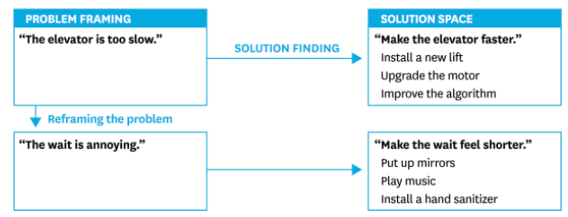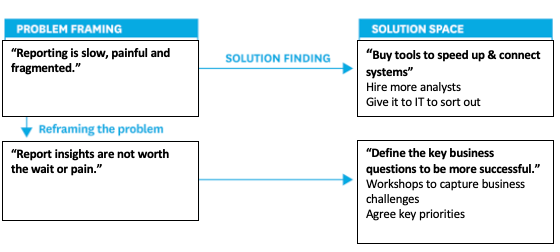Ammonite
Call us on +44 020 3693 1600


The Slow Elevator Problem.
Imagine this: You are the owner of an office building, and your tenants are complaining about the elevator. It’s old and slow, and they have to wait a lot. Several tenants are threatening to break their leases if you don’t fix the problem.
When asked, most people suggest seemingly obvious solutions: replace the lift, install a stronger motor, or perhaps upgrade the algorithm that runs the lift. These suggestions fall into a cluster of solutions that share assumptions about what the problem is—in this case, that the elevator is slow.

However, when the problem is handed to the building managers, they suggest a different solution: Put up mirrors next to the elevator. This measure reduces complaints because people lose track of time when given something fascinating to look at…themselves.

The mirror solution is particularly interesting because it is not a solution to the stated problem: It doesn’t make the elevator faster. Instead, it proposes a different understanding of the problem.
Reframing of the problem is often essential to good diagnosis & effective problem solving … but if you’re the tenant emotionally invested in the problem, that’s particularly hard to do!
What most companies struggle with isn’t solving problems but figuring out what the problems are.
From Albert Einstein to Peter Drucker, many leaders have emphasised the importance of good problem diagnosis. But so many organisations struggle to get it right.
So how does this relate to data?
When it comes to data there is a common misconception, especially within SMEs where data expertise is often limited, to see it as fundamentally a systems problem. Typically, the initial focus is how to connect disparate, fragmented systems.
There is an unspoken belief that ‘if we can just connect the data sets & get a (colourful) dashboard then we’ll become a data driven organisation.’
It’s understandable, as this is where they are experiencing pain so it’s where the focus goes.
The frustration from their staff about the slow, manual painful process to get out basic reports is the symptom most experienced on a day-to-day basis.
However, the outcome with this approach is an ever-increasing patch work of systems & tools – getting ever more confused as they go further down the rabbit hole, purchasing technology they don’t need, committing more money & time without clarity on how this will help the business long term & when they can expect to see value.
These are the companies that make up the 80% failure rate. After 2 years, with £000’s down the drain, frustration brewing & resentment building, they throw in the towel.
Reframing the data challenge
To break this cycle, SME business leaders can reframe the data challenge from connecting systems to asking a much more fundamental business question … a shift to focus entirely onto the business challenges, both now & in the future: What do we want to know about our business to be more successful?
At this stage, it’s a good idea to have a swear jar for anyone who mentions systems or technology. A pound in the jar for anyone who mentions Google Analytics or PowerBI!
Now, although this seems like a simple question on the surface, it’s actually much more complex & nuanced, one that many business leaders struggle to articulate.
But with guidance & an expert external viewpoint without the company baggage, these conversations will change the game.
Correlations between data sets that were never imagined previously, now seem obvious & necessary. The company will finally have clarity on where & how data will add significant value to business.

Once your organisation has agreed on the critical business challenges where insights can have the biggest impact, work backwards from there.
Only then can you map out how data will be captured, integrated, managed & moved around your organisation; which processes, governance & controls you’ll need; which skills you’ll require; & finally which systems can do the job. In that order.
The outcome of this approach is evidence-based insights at the heart of decision making that consistently make a tangible impact on business outcomes, with sustainable, efficient processes & behaviours throughout the business that make this possible.
It’s a mindset shift from being reactive to the data month to month, to thinking strategically about your data.
SMEs who get good outcomes from their data investments reframe the data problem from connecting systems to asking great business questions. They don’t dive into buying technology thinking they are too small to worry about any of the above.
So, when the time comes to invest in data in your business, start with the right diagnosis of the problem to ensure you’re the 20% who get it right!
Ammonite specialise in taking SMEs through every stage of their data journey. Our process starts by facilitating collaborative workshops to identify & prioritise the key business challenges that data insights can solve for your business. And yes, there will be (systems) swear jar!
To arrange an initial call to start your data journey, please fill out the form below & we’ll be in touch.
(1) Are you solving the right problem? https://hbr.org/2017/01/are-you-solving-the-right-problems
(2) https://blogs.gartner.com/andrew_white/2019/01/03/our-top-data-and-analytics-predicts-for-2019/